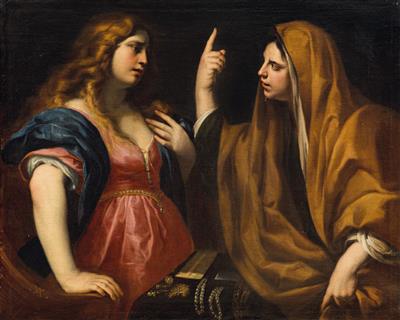Andrea Vaccaro

(Naples 1604–1670)
Martha and Mary,
monogrammed lower left: AV (ligated),
oil on canvas, 76 x 95.5 cm, framed
Provenance:
sale, Christie’s, Rome, 9 December, 1997, lot 368 (as Andrea Vaccaro);
Private collection, Italy;
where acquired by the present owner
Literature:
R. Lattuada, I percorsi di Andrea Vaccaro (1604-1670), in: M. Izzo, Nicola Vaccaro (1640-1709). Un artista a Napoli tra Barocco e Arcadia, Todi 2009, pp. 94-95, fig. 95 (as Andrea Vaccaro)
The present painting is registered in the Fototeca Zeri (no. 50492) as Andrea Vaccaro.
The present painting represents the subject of Martha rebuking Mary for her vanity, which the Neapolitan painter Andrea Vaccaro revisited on several occasions. A version which is similar to the present painting, but slightly larger (100 x 127 cm), is conserved in the Utah Museum of Fine Arts, Salt Lake City (inv. no. UMFA1973.080.005.005). This Biblical subject was considerably sought after and was frequently replicated during the 17th century.
The composition of the present canvas represents two half-length figures who fill the foreground; it is close to other private devotional works by the artist in which, when compared to his works for church commissions, appear to have a greater freedom in the choice of subject, and a notable quality of refined sensuality.
In the present painting, Martha of Bethany, one of Christ’s first followers as the Gospel according to Luke reports, rebukes her sister Mary for her inability to renounce the accoutrements of luxury: her rich dress, hairstyle and the jewellery and comb visible on the table in the foreground. However, Mary’s unbound hair is a symbol of penitence and suggests that she has entered into a process of atonement, indeed she has begun to unlace her dress and has taken off her jewels.
Andrea Vaccaro belonged to an important family of artists: his career was based in Naples and its immediate surroundings, where he received important ecclesiastical commissions, as well as working both for Neapolitan and Spanish clients. His training followed the current of Caravaggist painters, and in particular Ribera and Battistello Caracciolo. Perhaps not by co-incidence one of his first commissions was to copy Caravaggio’s Flagellation of Christ, as a replacement for the original in San Domenico Maggiore, which was moved to Capodimonte.
From the later 1630s Vaccaro asserted himself as a great interpreter of a new stylistic tendency that was then evolving in Naples. This was characterised by a neo-venetian palette influenced by Van Dyke and the noble compositional solutions of Bolognese painting. These features are evident in the present painting, in the luminous flesh tones and in the lively reflections on the subject’s dress, along with the restrained overall pictorial language, typical of the artist, who enjoyed enormous success with the patrons of the age.
17.10.2017 - 18:00
- Estimate:
-
EUR 40,000.- to EUR 60,000.-
Andrea Vaccaro
(Naples 1604–1670)
Martha and Mary,
monogrammed lower left: AV (ligated),
oil on canvas, 76 x 95.5 cm, framed
Provenance:
sale, Christie’s, Rome, 9 December, 1997, lot 368 (as Andrea Vaccaro);
Private collection, Italy;
where acquired by the present owner
Literature:
R. Lattuada, I percorsi di Andrea Vaccaro (1604-1670), in: M. Izzo, Nicola Vaccaro (1640-1709). Un artista a Napoli tra Barocco e Arcadia, Todi 2009, pp. 94-95, fig. 95 (as Andrea Vaccaro)
The present painting is registered in the Fototeca Zeri (no. 50492) as Andrea Vaccaro.
The present painting represents the subject of Martha rebuking Mary for her vanity, which the Neapolitan painter Andrea Vaccaro revisited on several occasions. A version which is similar to the present painting, but slightly larger (100 x 127 cm), is conserved in the Utah Museum of Fine Arts, Salt Lake City (inv. no. UMFA1973.080.005.005). This Biblical subject was considerably sought after and was frequently replicated during the 17th century.
The composition of the present canvas represents two half-length figures who fill the foreground; it is close to other private devotional works by the artist in which, when compared to his works for church commissions, appear to have a greater freedom in the choice of subject, and a notable quality of refined sensuality.
In the present painting, Martha of Bethany, one of Christ’s first followers as the Gospel according to Luke reports, rebukes her sister Mary for her inability to renounce the accoutrements of luxury: her rich dress, hairstyle and the jewellery and comb visible on the table in the foreground. However, Mary’s unbound hair is a symbol of penitence and suggests that she has entered into a process of atonement, indeed she has begun to unlace her dress and has taken off her jewels.
Andrea Vaccaro belonged to an important family of artists: his career was based in Naples and its immediate surroundings, where he received important ecclesiastical commissions, as well as working both for Neapolitan and Spanish clients. His training followed the current of Caravaggist painters, and in particular Ribera and Battistello Caracciolo. Perhaps not by co-incidence one of his first commissions was to copy Caravaggio’s Flagellation of Christ, as a replacement for the original in San Domenico Maggiore, which was moved to Capodimonte.
From the later 1630s Vaccaro asserted himself as a great interpreter of a new stylistic tendency that was then evolving in Naples. This was characterised by a neo-venetian palette influenced by Van Dyke and the noble compositional solutions of Bolognese painting. These features are evident in the present painting, in the luminous flesh tones and in the lively reflections on the subject’s dress, along with the restrained overall pictorial language, typical of the artist, who enjoyed enormous success with the patrons of the age.
|
Buyers hotline
Mon.-Fri.: 10.00am - 5.00pm
old.masters@dorotheum.at +43 1 515 60 403 |
| Auction: | Old Master Paintings |
| Auction type: | Saleroom auction |
| Date: | 17.10.2017 - 18:00 |
| Location: | Vienna | Palais Dorotheum |
| Exhibition: | 07.10. - 17.10.2017 |
